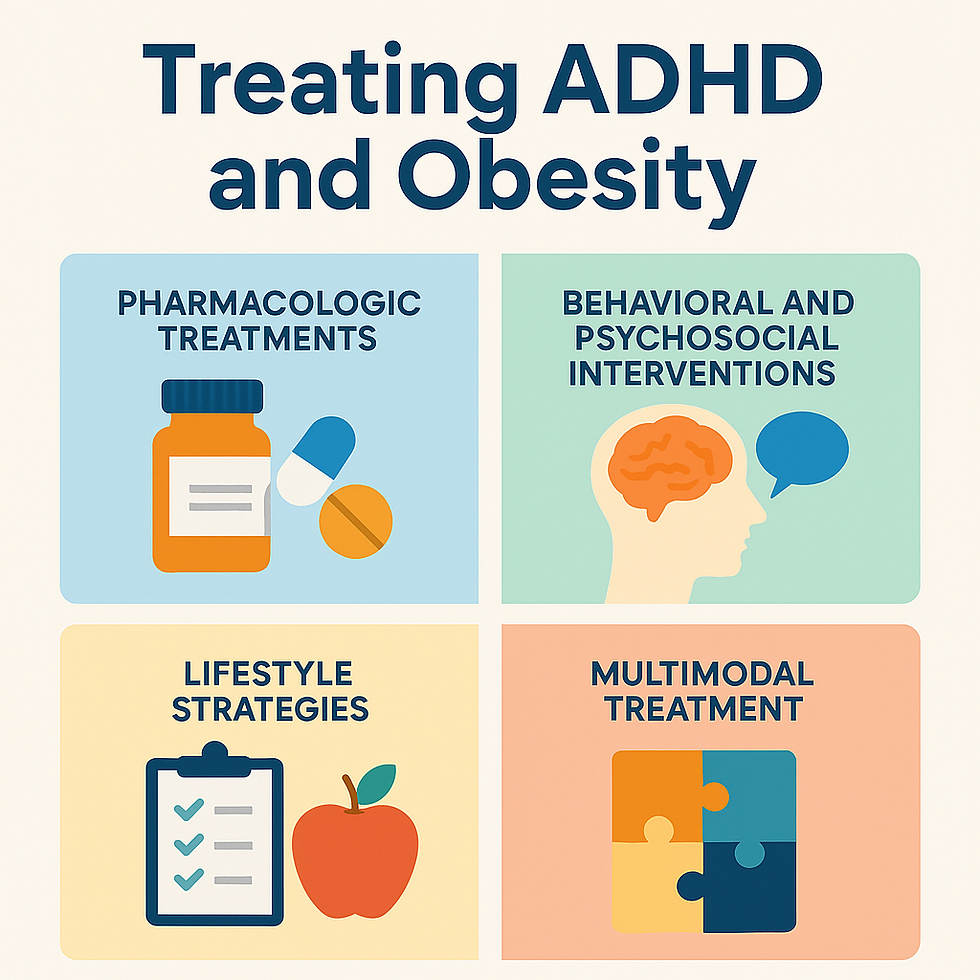ADHD and Obesity: Movement, Motivation, and ADHD
- Marian Brock-Andersen
- May 13
- 3 min read
Updated: Jun 17
How ADHD Can Impact Exercise and Physical Activity
Physical activity is influenced by ADHD symptoms, but it also serves as a powerful therapeutic tool. Unfortunately, individuals with ADHD commonly face unique challenges when trying to start and maintain consistent exercise routines. These difficulties arise from both cognitive-emotional and behavioral factors linked to ADHD.

Cognitive and Emotional Challenges
Inattention / Distractibility
Individuals may have difficulty focusing during workouts.
They might forget steps or instructions.
There is often a loss of interest in complex routines.
Poor Time Management
Many struggle to start exercise sessions on time.
Sticking to a regular schedule can be challenging.
Impulsivity
There is a tendency to overexert or skip warm-ups.
Taking unnecessary risks is common, potentially leading to injury.
Low Frustration Tolerance
Many feel discouraged when results aren't immediate.
This often results in decreased motivation.
Emotional Dysregulation
Mood swings and emotional instability can interfere with consistency and follow-through.
Behavioral Traits and Physical Patterns
Hyperactivity
Individuals experience a strong drive for movement.
High-energy activities, like martial arts or running, are ideal.
Need for Novelty
A preference for variety means individuals often get bored with repetitive routines.
Diverse or stimulating options are necessary to maintain interest.
Fidgeting or Excess Energy
Exercise serves as an excellent outlet to channel restlessness.
Engaging in physical activity can enhance focus afterward.
Why Exercise is a Therapeutic Tool for ADHD
Exercise isn't just affected by ADHD symptoms; it is also among the most effective non-pharmacological treatments for managing them. Regular physical activity benefits both brain function and emotional regulation, especially when used alongside therapy and/or medication.
| Benefit | How It Helps Individuals with ADHD |
|----------------------------------|---------------------------------------------------------------------------------------|
| Boosts Dopamine & Norepinephrine | These neurotransmitters improve focus, motivation, and mood. |
| Improves Executive Function | Enhances planning, working memory, and task-switching—skills commonly impaired in ADHD. |
| Reduces Anxiety & Depression | Helps manage these common comorbid conditions and supports emotional resilience. |
| Improves Sleep | Regular exercise enhances sleep quality, often disrupted in people with ADHD. |
| Provides a Productive Outlet | Releases excess energy and reduces hyperactive behavior in a structured way. |
One of the important tools for individuals managing ADHD symptoms is establishing a regular exercise routine. When combined with structured activities, they can reap the benefits of improved cognitive and physical well-being.
Practical Tips: Making Exercise Work for ADHD
Here are some practical strategies that can help individuals with ADHD successfully engage in physical activities:
Keep it Interesting: Select dynamic activities such as dance, martial arts, group fitness classes, or team sports.
Set Timers and Visual Reminders: Use reminders to start and end workouts or to prompt movement breaks.
Build Routine, Not Rigor: Emphasize consistent participation over perfection or intensity.
Exercise with a Buddy: Working out with someone adds social accountability and makes the activity more engaging.
Use It Strategically: A short workout before a mentally demanding task can act as a cognitive “reset.”
Engaging Physical Activities for ADHD
It’s essential to select enjoyable, interactive, and mentally engaging activities because individuals with ADHD might resist routines seen as repetitive or dull. Research supports the use of novelty-driven and immersive formats, particularly in children. A landmark review by Hoza et al. (2015) found that enjoyable physical activities significantly improve behavior and attention in children with ADHD. Movement-based games and interactive sports not only increase adherence but also enhance cognitive function.
Recent studies have highlighted the role of Virtual Reality (VR) and active video games in treating ADHD:
VR classroom environments have improved executive function, memory, and behavioral regulation (Blume et al., 2017).
VR sports and game-based interventions have shown effectiveness in enhancing focus, decision-making, and social functioning through movement combined with immersive feedback (Zhang et al., 2024).
Incorporating these innovative activities into an ADHD treatment plan can bring about both cognitive and physical benefits, ultimately enhancing the quality of life for individuals and assisting in treatment engagement.
References
Blume, F., Hudak, J., Dresler, T., Ehlis, A. C., Kühnhausen, J., Renner, T. J., & Gawrilow, C. (2017). NIRS-based neurofeedback training in a virtual reality classroom for children with attention-deficit/hyperactivity disorder: Study protocol for a randomized controlled trial. Trials, 18(1), 41. https://doi.org/10.1186/s13063-016-1769-3
Hoza, B., Martin, C. P., Pirog, A., Shoulberg, E. K., & Valente, M. (2015). Using physical activity to manage ADHD symptoms: The state of the evidence. Current Psychiatry Reports, 17(12), 1–9. https://doi.org/10.1007/s11920-015-0638-3
Zhang, W., Li, H., & Sheng, Y. (2024). A study of the effects of virtual reality-based sports games on improving executive and cognitive functions in minors with ADHD—A meta-analysis of randomized controlled trials. Behavioral Sciences, 14(12), 1141. https://doi.org/10.3390/bs14121141




Comments